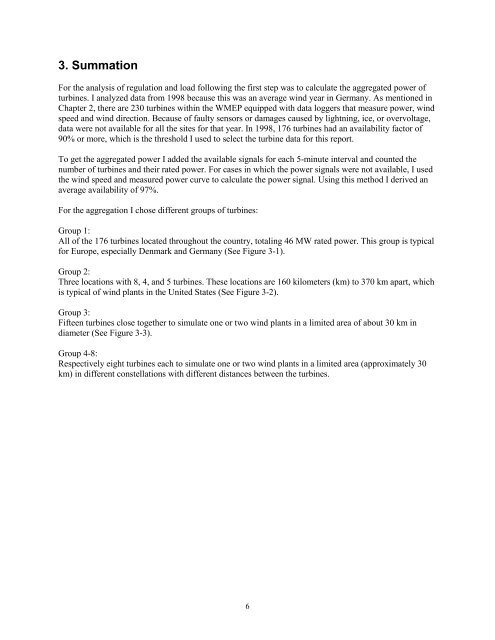Analysis of Wind Power Ancillary Services Characteristics ... - NREL
Analysis of Wind Power Ancillary Services Characteristics ... - NREL
Analysis of Wind Power Ancillary Services Characteristics ... - NREL
Create successful ePaper yourself
Turn your PDF publications into a flip-book with our unique Google optimized e-Paper software.
3. Summation<br />
For the analysis <strong>of</strong> regulation and load following the first step was to calculate the aggregated power <strong>of</strong><br />
turbines. I analyzed data from 1998 because this was an average wind year in Germany. As mentioned in<br />
Chapter 2, there are 230 turbines within the WMEP equipped with data loggers that measure power, wind<br />
speed and wind direction. Because <strong>of</strong> faulty sensors or damages caused by lightning, ice, or overvoltage,<br />
data were not available for all the sites for that year. In 1998, 176 turbines had an availability factor <strong>of</strong><br />
90% or more, which is the threshold I used to select the turbine data for this report.<br />
To get the aggregated power I added the available signals for each 5-minute interval and counted the<br />
number <strong>of</strong> turbines and their rated power. For cases in which the power signals were not available, I used<br />
the wind speed and measured power curve to calculate the power signal. Using this method I derived an<br />
average availability <strong>of</strong> 97%.<br />
For the aggregation I chose different groups <strong>of</strong> turbines:<br />
Group 1:<br />
All <strong>of</strong> the 176 turbines located throughout the country, totaling 46 MW rated power. This group is typical<br />
for Europe, especially Denmark and Germany (See Figure 3-1).<br />
Group 2:<br />
Three locations with 8, 4, and 5 turbines. These locations are 160 kilometers (km) to 370 km apart, which<br />
is typical <strong>of</strong> wind plants in the United States (See Figure 3-2).<br />
Group 3:<br />
Fifteen turbines close together to simulate one or two wind plants in a limited area <strong>of</strong> about 30 km in<br />
diameter (See Figure 3-3).<br />
Group 4-8:<br />
Respectively eight turbines each to simulate one or two wind plants in a limited area (approximately 30<br />
km) in different constellations with different distances between the turbines.<br />
6
















